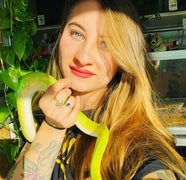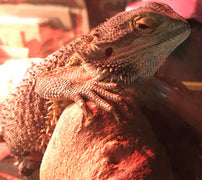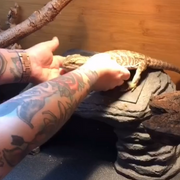Bearded Dragon Care Sheet by ReptiFiles

Bearded Dragon Care Sheet by ReptiFiles
Bearded dragons are lizards native to eastern and central Australia. They can be found in a variety of habitats, from the desert to scrub lands and even dry forests. They earned their name from their spiky, expandable throat pouch that can look very much like a beard, especially when it turns black.
These lizards are diurnal, meaning that they are most active during the day. They love to bask, and are commonly found sunbathing on everything from rocks and fallen branches to fence posts and picnic tables in their natural habitat.
Since they are diurnal, they also do their hunting during the day. Bearded dragons are omnivorous, so aside from munching a variety of vegetation, they mostly prey upon insects.
Bearded dragons grow to 18″-24″ long and have a lifespan of 10-15 years. They are usually fully grown by 2 years old.
Their natural coloration is dull brown or tan with red or gold highlights, depending on local soil color, but modern breeding practices have produced a variety of color morphs from white to dark red. Some morphs are even multicolored, with patches of blue or purple!
Bearded dragons are exceptionally popular as pets, with a calm, curious temperament and array of social behaviors that makes them a safe, entertaining first reptile.
Shopping List
- Meridian 4'x2'x2' Wood Panel Reptile Enclosure
- OR Meridian 4'x2'x2' PVC Panel Reptile Enclosure
- 8-10” dome heat lamp with a ceramic socket
- high-wattage PAR38 halogen flood bulb, white light
- plug-in lamp dimmer
- digital thermometer with probe
- 22-24” T5 HO desert UVB bulb and fixture
- light timer
- substrate/bedding (Zen Mat)
- basking surface (ex: flagstone)
- hide/cave (Zen Cave or Zen Corner Cave)
- decorations (logs, branches, rocks, etc.)
- food and water dishes
- calcium supplement without vitamin D3
- multivitamin supplement
- soft-tipped feeding tweezers
Keep reading for specifics on the supplies that you will need!
Terrarium Size
Modern bearded dragon husbandry experts recommend keeping bearded dragons in no smaller than a 120 gallon (48”x24”x24”) enclosure. The enclosure should be front-opening for easy access, preferably with a screen top for ventilation.
Can 2 bearded dragons be housed together?
It’s so tempting to buy more than one bearded dragon! However, if you choose to buy two (or more), keep in mind that bearded dragons should ALWAYS be housed separately. Bearded dragons are territorial, which means that they will attack other beardies in their space, sometimes causing serious or even fatal injuries. Even if they seem to get along “just fine,” it’s always better be safe than sorry.
Bearded dragons are not social reptiles, and they don’t need “friends” or get lonely. So limit yourself to just 1 bearded dragon per enclosure.
Lighting & Temperatures
Lighting
Bearded dragons are diurnal, which means that they are active during the day. This means that they absolutely MUST have UVB lighting installed in their enclosure or else they will get sick and die.
The Zoo Med ReptiSun 10.0 T5 HO or Arcadia Desert 14%are fluorescent bulbs that provides the right amount of UVB for bearded dragons. These bulbs must be replaced once a year to be effective. For best results, install the bulb in a reflective fixture like the Zoo Med Reptisun T5 HO Terrarium Hood or Vivarium Electronics T5 HO Light Strip. Bulb and fixture should span 1/2 of the enclosure’s length.
When it comes to UVB, brand matters and you get what you pay for. Don’t cheap out on UVB, or your bearded dragon may suffer.
Temperatures
Unlike humans, bearded dragons are cold-blooded, which means that they need external heat for their bodies to work properly. Since bearded dragons are basking lizards, they use heat most effectively from an overhead heat source that mimics the sun.
Bearded dragons require a basking surface temperature of 105-115°F. The cool end of the enclosure (opposite from the basking area) can be between 75-85 degrees. The wattage it will take to accomplish this varies according to room temperature and distance between the lamp and the basking spot, but a Arcaida 100w Halogen Bulb should do the trick for a 24” tall enclosure. If it’s too hot, use the lamp dimmer to dial it down a bit.
How do you make sure you’re doing it right?
Don’t get a cheap gauge-type stick-on thermometer — these aren’t very accurate. Instead, use an infrared temperature gun to measure surface temperature. Using a digital probe thermometer like the Zoo Med Digital Thermometer is also a good way to track your basking temperature when the probe is placed on the basking surface.
Feeding Your Bearded Dragon
Insects
- < 2 months old: 2x daily
- 3-4 months old: 1x daily
- 4-12 months old: 4x weekly
- 12-18 months old: 3x weekly
- 18+ months old: 2x weekly
When choosing feeder bugs, make sure that they are no bigger than the space between your dragon’s eyes. All feeder insects should be coated in calcium supplement before feeding. For best results, give your dragon a large variety of bugs for best nutrition.
Good feeder insects include:
- Crickets
- Roaches
- Silkworms
- Black soldier fly larvae
Vegetables
Both juvenile and adult bearded dragons should receive a salad of nutritious greens and veggies daily. Since bearded dragons are omnivorous, they need a variety. Feeding a variety of veggies gives your dragon a good balance of the nutrients s/he needs to be healthy.
Staples:
- collard greens
- mustard greens
- arugula
- kale
- turnip greens
- cactus pads
Poison:
- avocado
- onion
Vegetables should be sliced into bite-sized pieces that your beardie can grab with his/her tongue.
Fruits
Up to 10% of your beardie’s diet may consist of fruit. Fruits tend to have a higher water content and more sugar than vegetables, so they must be fed sparingly. They make excellent treats, however.
- berries
- figs
- apples
- cactus fruit (aka prickly pear)
Poison:
- citrus
- rhubarb
Water
Bearded dragons do not often drink water from their bowls, but it’s still important to provide one. Choose a bowl that is large enough for the dragon to soak in as desired, but shallow enough to prevent drowning.
Supplements
To ensure that your beardie is getting all the vitamins and minerals they need, you need calcium powder and multivitamin powder. Take care not to use these too often; too much vitamins can be just as deadly as too little. We recommend Miner-ALL Outdoor (no D3) on all insects and Repashy Supervite sprinkled lightly on salad once a week.
Handling Tips
When you first bring your beardie home, resist the temptation to immediately start cuddling it. You’re huge compared to a bearded dragon, and s/he needs time to figure out that you’re not going to eat them. Let your dragon settle in for at least 2 weeks before you start handling.
Once your beardie has established confidence in his/her new home, you can introduce yourself. Let him/her get comfortable with your scent by placing an old, used shirt in the terrarium. Let your hand rest in the terrarium and allow the dragon to familiarize itself with your hand.
After your bearded dragon has stopped running away from your hand and seems calm in your presence, you can handle him/her. But just because you have reached this step does not mean your dragon trusts you. Trust and friendship (as far as it goes for lizards) takes time and daily handling.
Handling Techniques- Support all four feet. If one foot is left out, s/he will feel off balance and start to thrash to regain it.
- Use slow movements. Large, fast movements remind them of predators. Small, quick movements remind them of prey. Either way, it’s distracting.
- Petting is tolerated and sometimes even appreciated, but do so gently. Never tug, pull, or tap. Also resist rubbing against the direction of his/her scales.
- If your beardie is shedding, resist pulling at loose skin. You may pull off scales that haven’t completely detached yet.
 Log in
Log in


